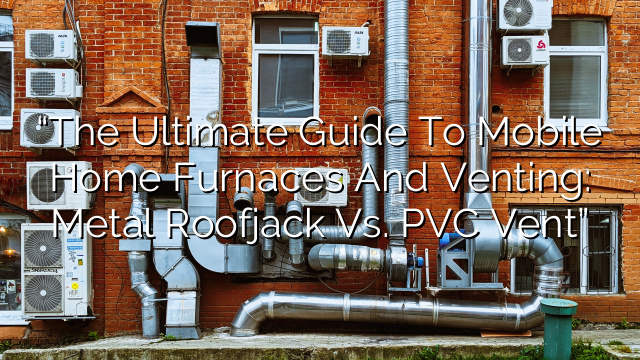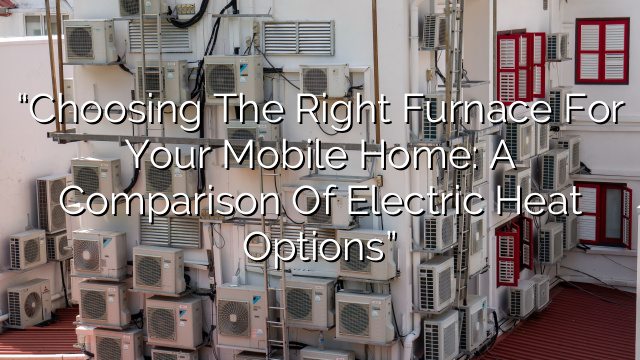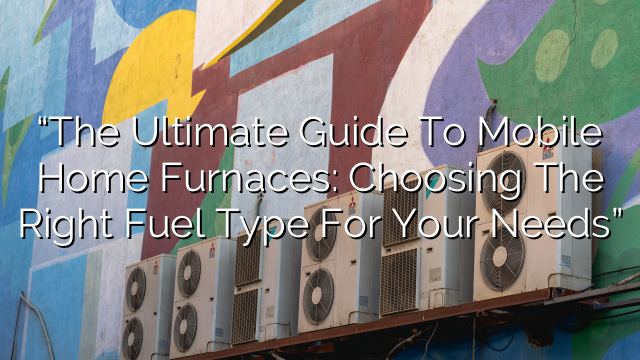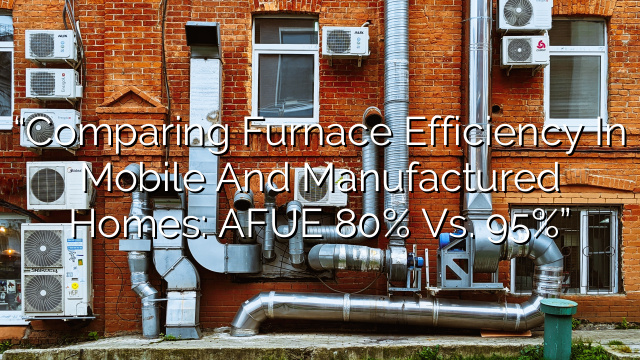Introduction
Mobile homes require a special type of furnace and venting system, different from those used in traditional homes. In this article, we will explore the different types of furnaces and venting options available for mobile homes, specifically focusing on metal roofjack and PVC venting. By the end of this guide, you will have a clear understanding of the advantages and disadvantages of each option.
Mobile Home Furnaces
Mobile home furnaces are specifically designed to fit the smaller space and unique needs of a mobile home. They are typically more compact and have lower BTU (British Thermal Unit) output compared to furnaces found in traditional homes. Mobile home furnaces can be divided into two main categories: mobile home electric furnaces and mobile home gas furnaces.
Mobile Home Electric Furnaces
Mobile home electric furnaces are powered by electricity and do not require a fuel source such as natural gas or propane. They are often more affordable upfront and easier to install compared to gas furnaces. However, they may have higher operating costs and may not provide the same level of heat output as gas furnaces.
Mobile Home Gas Furnaces
Mobile home gas furnaces are powered by natural gas or propane. They are known for their energy efficiency and high heat output. Gas furnaces are often more expensive upfront and require a professional installation. However, they can provide a more consistent and comfortable heating experience compared to electric furnaces.
Venting Types: Metal Roofjack and PVC Vent
The choice of venting system for mobile home furnaces is crucial for proper ventilation and safe operation. The two most common venting options for mobile homes are metal roofjack and PVC venting.
Metal Roofjack
Metal roofjack venting utilizes a metal pipe that extends through the roof of the mobile home. It is a traditional and reliable venting option that has been used for many years. Metal roofjacks are durable and provide effective ventilation for the furnace. They are designed to withstand various weather conditions and are less prone to damage compared to PVC vents. Metal roofjacks also have a longer lifespan, making them a popular choice among mobile homeowners.
PVC Vent
PVC venting, on the other hand, utilizes PVC pipes for venting the combustion gases outside. PVC vents are often flexible and easier to install compared to metal roofjacks. They are also resistant to rust and corrosion. However, PVC vents may not be as durable as metal roofjacks, especially in areas with extreme weather conditions. PVC vents may require more frequent maintenance and replacement due to potential wear and tear. It is important to consider the climate and weather conditions of your area when deciding between metal roofjack and PVC venting.
Advantages of Metal Roofjack
- Metal roofjacks are durable and have a longer lifespan compared to PVC vents.
- They provide reliable ventilation for mobile home furnaces.
- Metal roofjacks are designed to withstand various weather conditions.
- They are less prone to damage compared to PVC vents.
Advantages of PVC Vent
- PVC vents are flexible and easier to install compared to metal roofjacks.
- They are resistant to rust and corrosion.
- PVC vents are less expensive compared to metal roofjacks.
- They can be a suitable option for mobile homes in moderate climates or areas with less extreme weather conditions.
Disadvantages of Metal Roofjack
- Metal roofjacks may be more expensive upfront compared to PVC vents.
- They require professional installation and may require modifications to the roof of the mobile home.
- Metal roofjacks may not be suitable for areas with extreme weather conditions.
Disadvantages of PVC Vent
- PVC vents may require more frequent maintenance and replacement due to wear and tear.
- They may not be as durable as metal roofjacks.
- PVC vents may not be suitable for areas with extreme weather conditions.
Conclusion
Choosing the right type of furnace and venting system for your mobile home is essential for safety and optimal heating performance. Metal roofjack and PVC venting are two common options for mobile homes. Metal roofjacks offer durability and reliability, while PVC vents provide flexibility and ease of installation. Considering the climate and weather conditions of your area, as well as your budget and preferences, will guide you in making the right decision.
FAQs
Q: Can a mobile home furnace be replaced with a traditional home furnace?
A: No, a mobile home furnace has specific design and size requirements that are different from those of a traditional home furnace. It is important to install a specially designed furnace for mobile homes to ensure proper fit and function.
Q: Can I install a metal roofjack or PVC vent myself?
A: It is recommended to hire a professional HVAC technician for the installation of a metal roofjack or PVC vent. They have the expertise and knowledge to ensure proper installation and compliance with safety standards.
Q: How often should I clean and maintain my furnace and venting system?
A: Regular maintenance, including cleaning and inspection, is recommended for optimal performance and safety. Consult your furnace manufacturer’s guidelines and consider scheduling professional maintenance at least once a year.
Q: Can I switch from a gas furnace to an electric furnace in my mobile home?
A: It is possible to switch from a gas furnace to an electric furnace in your mobile home, but it may require modifications and professional installation. Consult with an HVAC professional to determine if it is feasible and cost-effective for your specific situation.
Q: Can I use a metal roofjack for a PVC vent or vice versa?
A: It is not recommended to mix different venting types. Each venting option is designed specifically for its intended purpose and using the wrong type may compromise safety and efficiency.





